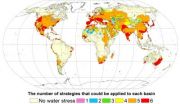(Press-News.org) A leading U.S. Ebola researcher from the University of Texas Medical Branch at Galveston has gone on record stating that a blend of three monoclonal antibodies can completely protect monkeys against a lethal dose of Ebola virus up to 5 days after infection, at a time when the disease is severe.
Thomas Geisbert, professor of microbiology and immunology, has written an editorial for Nature discussing advances in Ebola treatment research. The filoviruses known as Ebola virus and Marburg virus are among the most deadly of pathogens, with fatality rates of up to 90 percent.
Since the discovery of Ebola in 1976, researchers have been actively working on treatments to combat infection. Studies over the past decade have uncovered three treatments that offer partial protection for monkeys against Ebola when given within an hour of virus exposure. One of these treatments, a VSV-based vaccine was used in 2009 to treat a laboratory worker in Germany shortly after she was accidentally stuck with a needle possibly contaminated by an Ebola-infected animal.
Further advances have been made that can completely protect monkeys against Ebola using small 'interfering' RNAs and various combinations of antibodies. But these treatments need to be given within two days of Ebola exposure.
"So although these approaches are highly important and can be used to treat known exposures, the need for treatments that can protect at later times after infection was paramount," said Geisbert.
Further research led to a cocktail of monoclonal antibodies that protected 43% of monkeys when given as late as five days after Ebola exposure, at a time when the clinical signs of the disease are showing.
The new study from Qui and colleagues at MAPP Biopharmaceutical Inc. used ZMAPP to treat monkeys given a lethal dose of Ebola. All of the animals survived and did not show any evidence of the virus in their systems 21 days after infection, even after receiving the treatment 5 days after infection. They also showed that ZMAPP inhibits replication of the Ebola virus in cell culture.
ZMAPP has been used to treat several patients on compassionate grounds. Of these, two US healthcare workers have recovered, although but whether ZMAPP had any effect is unknown, as 45% of patients in this outbreak survive without treatment. There were also two patients treated with ZMAPP who did not survive, but this may be because the treatment was started too late in the disease course.
"The diversity of strains and species of the Ebola and Marburg filoviruses is an obstacle for all candidate treatments," said Geisbert. "Treatments that may protect against one species of Ebola will probably not protect against a different species of the virus, and may not protect against a different strain within the species."
Although we certainly need treatments for filovirus infections, the most effective way to manage and control future outbreaks might be through vaccines, some of which have been designed to protect against multiple species and strains. During outbreaks, single-injection vaccines are needed to ensure rapid use and protection. At least five preventative vaccines have been reported to completely protect monkeys against Ebola and Marburg infection. But only the VSV-based vaccines have been shown to complete protect monkeys against Ebola after a single injection.
"Antibody therapies and several other strategies should be included in the arsenal of interventions for controlling future Ebola outbreaks," said Geisbert. "Although ZMAPP in particular has been administered for compassionate use, the next crucial step will be to formally assess its safety and effectiveness."
INFORMATION:
Leading Ebola researcher at UTMB says there's an effective treatment for Ebola
2014-08-29
ELSE PRESS RELEASES FROM THIS DATE:
Assortativity signatures of transcription factor networks contribute to robustness
2014-08-29
Dartmouth researchers explored the type and number of connections in transcription factor networks (TFNs) to evaluate the role assortativity plays on robustness in a study published in PLOS Computational Biology in August. The study found that the assortativity signature contributes to a network's resilience against mutations.
"In simulations, it seems that varying the out-out assortativity of TFN models has a greater effect on robustness than varying any of the other three types of assortativity," said Dov A. Pechenick, PhD, lead author and former researcher at the ...
Revealing a novel mode of action for an osteoporosis drug
2014-08-29
Raloxifene is a U.S. Food and Drug Administration (FDA)-approved treatment for decreasing fracture risk in osteoporosis. While raloxifene is as effective at reducing fracture risk as other current treatments, this works only partially by suppressing bone loss. With the use of wide- and small-angle x-ray scattering (WAXS and SAXS, respectively), researchers carried out experiments at the U.S. Department of Energy's (DOE's) Advanced Photon Source (APS) at Argonne National Laboratory that revealed an additional mechanism underlying raloxifene action, providing an explanation ...
Study reveals how Ebola blocks immune system
2014-08-29
Researchers at the Washington University School of Medicine have identified one way the Ebola virus dodges the body's antiviral defenses, providing important insight that could lead to new therapies, in research results published in the journal Cell Host & Microbe.
In work performed at Beamline 19ID at Argonne National Laboratory's Advanced Photon Source, the researchers developed a detailed map of how a non-pathogenic Ebola protein, VP24, binds to a host protein that takes signaling molecules in and out of the cell nucleus.
Their map revealed that the viral protein ...
Argonne scientists pioneer strategy for creating new materials
2014-08-29
Making something new is never easy. Scientists constantly theorize about new materials, but when the material is manufactured it doesn't always work as expected. To create a new strategy for designing materials, scientists at the Department of Energy's Argonne National Laboratory combined two different approaches at two different facilities to synthesize new materials.
This new strategy gives faster feedback on what growth schemes are best, thus shortening the timeframe to manufacture a new, stable material for energy transport and conversion applications.
A recent ...
Aging Africa
2014-08-29
Boulder, Colorado, USA – In the September issue of GSA Today, Paul Bierman of the University of Vermont–Burlington and colleagues present a cosmogenic view of erosion, relief generation, and the age of faulting in southernmost Africa. By measuring beryllium-10 (10Be) in river sediment samples, they show that south-central South Africa is eroding at the slow rate of about five meters per million years, consistent with rates in other non-tectonically active regions.
By measuring 10Be and aluminum-26 (26Al) in exposed quartzites, Bierman and colleagues find that undeformed ...
Preventing cancer from forming 'tentacles' stops dangerous spread
2014-08-29
EDMONTON, AB – A new study from the research group of Dr. John Lewis at the University of Alberta (Edmonton, AB) and the Lawson Health Research Institute (London, ON) has confirmed that "invadopodia" play a key role in the spread of cancer. The study, published in Cell Reports, shows preventing these tentacle-like structures from forming can stop the spread of cancer entirely.
Roughly 2 in 5 Canadians will develop cancer in their lifetime, and one in four of them will die of the disease. In 2014, it's estimated that nine Canadians will die of cancer every hour. Thanks ...
Reducing water scarcity possible by 2050
2014-08-29
Water scarcity is not a problem just for the developing world. In California, legislators are currently proposing a $7.5 billion emergency water plan to their voters; and U.S. federal officials last year warned residents of Arizona and Nevada that they could face cuts in Colorado River water deliveries in 2016.
Irrigation techniques, industrial and residential habits combined with climate change lie at the root of the problem. But despite what appears to be an insurmountable problem, according to researchers from McGill and Utrecht University it is possible to turn the ...
Evidence mounting that older adults who volunteer are happier, healthier
2014-08-29
Toronto, Canada – Older adults who stay active by volunteering are getting more out of it than just an altruistic feeling – they are receiving a health boost!
A new study, led by the Rotman Research Institute at Baycrest Health Sciences and published online this week in Psychological Bulletin, is the first to take a broad-brush look at all the available peer-reviewed evidence regarding the psychosocial health benefits of formal volunteering for older adults.
Lead investigator Dr. Nicole Anderson, together with scientists from Canadian and American academic centres, ...
NASA sees Hurricane Cristobal racing through North Atlantic
2014-08-29
Satellite imagery shows Hurricane Cristobal racing through the North Atlantic on Friday, August 29 while losing its tropical characteristics. An image from NOAA's GOES-East satellite showed Cristobal headed south of Greenland. The previous day, NASA's TRMM satellite saw heavy rainfall occurring in the hurricane.
In a visible image from NOAA's GOES-East satellite on August 29 at 7:45 a.m. EDT, Hurricane Cristobal was moving through the North Atlantic about 500 miles southwest of Greenland. The image was created by the NASA/NOAA GOES Project at NASA's Goddard Space Flight ...
CCNY team defines new biodiversity metric
2014-08-29
To understand how the repeated climatic shifts over the last 120,000 years may have influenced today's patterns of genetic diversity, a team of researchers led by City College of New York biologist Dr. Ana Carnaval developed a new biodiversity metric called "phylogeographic endemism."
It quantifies the degree to which the genetic variation within species is restricted in geographical space.
Dr. Carnaval, an assistant professor of biology, and 14 other researchers from institutions in Brazil, Australia and the United States, analyzed the effects of current and past climatic ...


